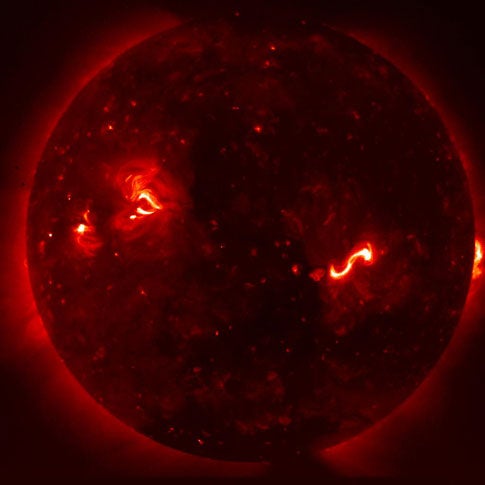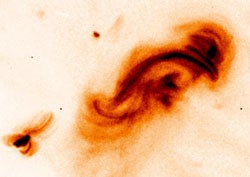Sharp images from a new X-ray telescope will make it easier to predict solar explosions that could damage satellites, interrupt radio signals or expose astronauts to hazardous radiation, says Montana State University researcher David McKenzie. That’s because the new images reveal how the magnetic fields on the Sun are arranged into twisted structures whose unique shape holds new clues to formation of these magnetic storm clouds.
Predictions about solar explosions are as valuable in space as weather forecasts are on the ground, McKenzie said as he prepared to present recent results last week at the American Astronomical Society meeting in Honolulu, Hawaii. In analysis carried out by McKenzie and fellow MSU researcher Richard Canfield, the scientists used images of the Sun’s atmosphere to distinguish between competing explanations for the shape of solar features that are responsible for potentially dangerous eruptions.
MSU researchers are among those operating the X-ray telescope that was launched last fall from Japan. The telescope is one of three riding on the Hinode satellite, a Japanese mission with the US and UK as partners. Besides the X-ray telescope, the satellite is carrying a telescope for visible light and one for extreme ultraviolet images. Together, the telescopes show how changes on the Sun’s surface spread through the solar atmosphere. The satellite is orbiting 431 miles above ground, crossing both poles and making one lap every 95 minutes.
This orbit gives Hinode an uninterrupted view of the Sun for several months out of the year, allowing scientists to watch storms develop. It is relaying thousands of images a day, and the new images are more spectacular than he expected, McKenzie said. “Based on MSU’s experience with previous solar satellites I had an idea what the images were going to look like, but they are even more exciting than I thought they would be.”
By revealing the internal framework of magnetic structures on the Sun, the new sharper images have allowed scientists to distinguish between competing theories about the formation of those structures. Says Canfield, “It’s important because knowing how the things are put together puts us on the track to predicting their behavior,” such as when they might explode.
Finding the right explanation for the ‘S’ shape wasn’t easy. Over the years, researchers have developed competing explanations for how sigmoids are formed, but when McKenzie and Canfield compared Hinode observations with the models, the new images showed that one explanation was better than the other. According to the MSU researchers, Hinode images of a sigmoid observed for three days in February show that zooming in on the S reveals many fine strands gathered into two back-to-back J-shapes. Zoom out, and the two J’s seem to merge into the familiar S seen by previous telescopes. Only one of the models studied predicts the “two-J” shape observed by Hinode.
When the sigmoid erupted on February 12th of this year, Hinode caught the action. “The eruption as viewed by Hinode looked just as the theory predicted it would,” said Canfield. “Now we can see clearly—in at least this one case—how these eruptive magnetic fields are put together. And just as understanding the formation of storm clouds helps to predict earthly weather, these new findings bring us closer to predicting the largest explosions in the solar system.”
Better prediction of solar eruptions is of interest to those who operate satellites, power grids, and oil pipelines, to name a few. Satellite operators who know when the Sun is about to hurl material towards Earth can make plans to turn off high voltage systems, for example. Astronauts will know when it’s best to stay inside their spacecraft.
“It’s not so important to predict when the northern lights will occur, but it sure is helpful to be able to tell the power company when to look out for trouble,” McKenzie said.











